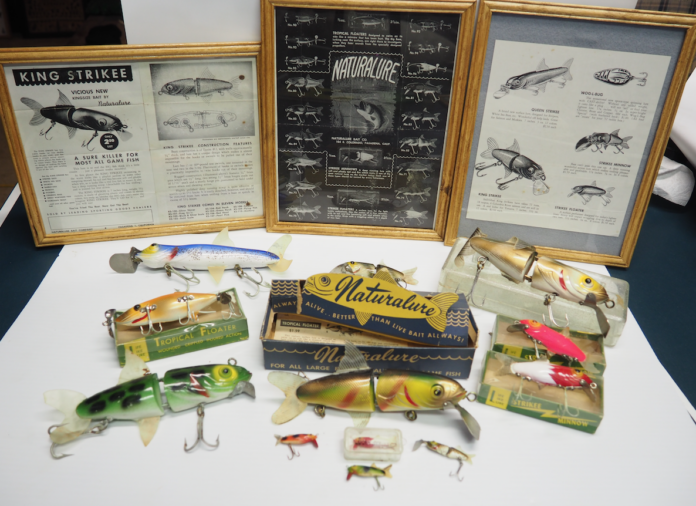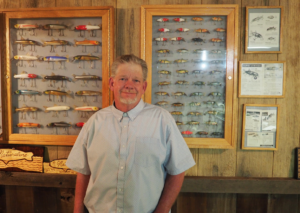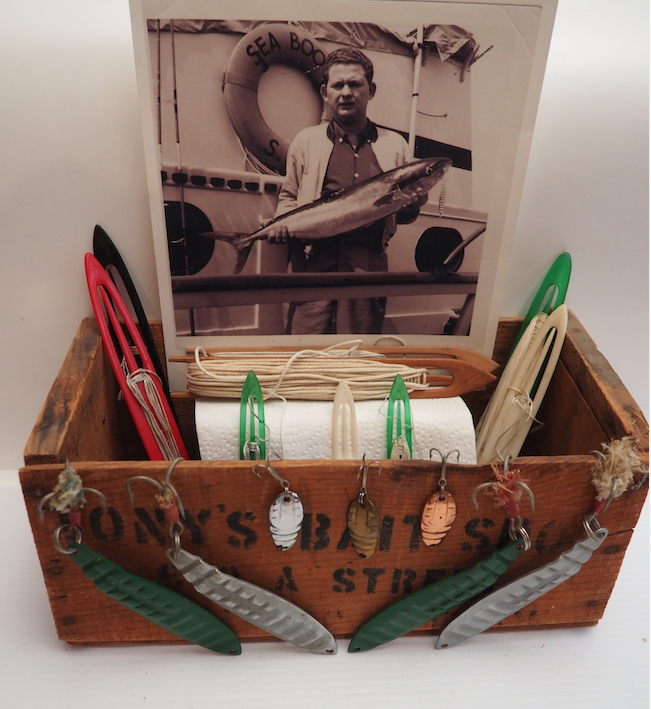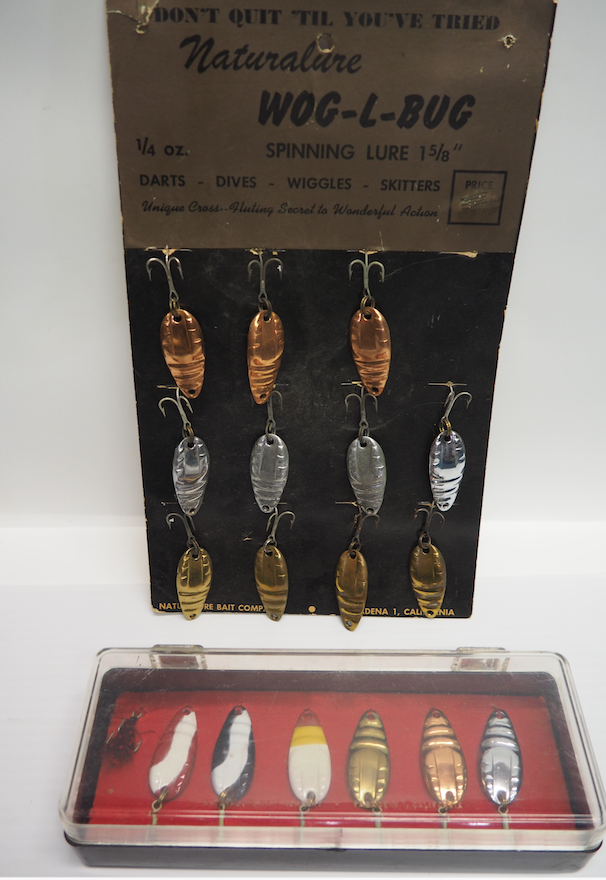
Early pre-1950 California plastic swimbait Strikee lures, metal Wog-L-Bugs and Skooter saltwater jigs
BY BUD CHADDOCK
As you may have surmised from my first three columns, I am fascinated with the development of terminal tackle, reels and lures used in the emerging days of Southern California fishing. As a native Southern Californian, I was blessed to spend many days on the water and off of the shorelines and piers fishing as a young man, and hear the stories of legendary captains and boats.
The Robert Brady Naturalure Bait Company is a part of early California sportfishing history with lures made here in the U.S. and used all over the world. I was fortunate to run into Robert’s son, Pat, at an antique tackle show, and we had the opportunity to exchange our passion for our collections. Thanks to Pat Brady for all he had to share about his family heritage and the love they have for the outdoors and the products they made.
Robert Brady, born in 1922, served in the United States Marines until 1945. This would be the beginning of a life of adventure for a man pursuing his dreams. Brady had a passion for fishing, and what better thing to do than to follow his dreams and ambitions. He used his thoughts and his passion for fishing to create something tangible for others to use and enjoy. He began making fishing lures that he designed and then used. His endeavor to pursue his dreams served as an example for others. Many angling adventures started with a few of Brady’s creations in a tackle box which was carried onto a boat.

The Brady Naturalure Bait Company started in Pasadena in 1948 and continued until 1959. His innovative design of the first workable plastic was used to make lures in the pre-1950 era, and his formula held up better than Heddon, Creek Chub and several others that tried with limited success. They had shrinkage problems after molding the lures, as well as a chemical reaction that made them gummy and split.
Brady employed a space-age approach which he used while working with plastics at Dupont, developing his own formula on his own time in his shop. Other companies tried to get him to give up the formula, but he declined their advances, as really had something in the plastic he developed. To this day, many are like new when found in that elusive tackle box and don’t have shrinkage and malformations of others made at that time.
The other unique thing about this lure was its lifelike, undulating fins. Brady took a long time to develop a special glue that would adhere the fins with black striations to mimic fin rays. After many attempts, he formulated a special glue to attach the fins. This was needed because the fins were made from cow gut that was taken from slaughterhouses and then stretched and dried flat. It was then cut out into cookie cutter-style shaped fins to replicate a fin that appears natural and lifelike, which was innovative for its time. Now plastics are made for tail replacements on modern wake baits and swimbaits.
His creativity didn’t stop with just one design. He made jointed versions, straight versions, deep-running, shallow-running, floating and sub-surface models, trout and bass spoons and yellowtail jigs. The yellowtail jigs are very hard to come by for those who enjoy collecting the older irons. You can clearly see Brady’s talent and creativity as he holds up a yellowtail caught on one of his Skooter jigs which he designed.

Robert’s son Patrick shared some advertisements his father placed in magazines from 1948 to 1959, which highlighted many models of lures offered to the public at retail stores. The largest jointed lure was the King Strikee. The advertisement reads, “Individual King Strikees have taken 72 tuna, 18 tarpon, 6 Columbia River salmon and are still in use. A real killer for Totuava…”
They could be trolled at 1.5 knots with the diving lip or you could detach the diving lip if that was your preference. The Totuava is a large form of seabass found in the Sea of Cortez sometimes weighing in over 200 pounds (when I was a child there were many stories in Western Outdoor News about such catches and pictures of these goliath-sized seabass-like fish).
This model was available in 12 colors and were 7 inches in size and weighed 3.5 ounces. The cost was $2.50 each. This lure could be trolled or cast a long ways due to its size. The next one is the straight model in stature, designed for fishing surface to catch stripers and white seabass, and was also used along kelp beds for calico bass. They’re also great for salmon and muskies. They’re also 7 inches long, 3 ounces and came in 12 colors at $2.50 each.
Next up is the Strikee Minnow that is a deep-diving model that is jointed and good for bass, walleye and northern pike in freshwater. It was 5/8-ounce, 3 7/8 inches long and came in 8 different colors. Next is the Strikee Floater straight model at 3/8-ounces, 3.5 inches and dives to 2 feet but when stopped, it floated to the top. This was a good variable speed lure and was offered in 7 different colors, and the cost was $1.50.
In addition, there was a topwater lure that I used as a young man, which I found when I opened my own grandfather’s tackle box. It looked cool, so I tied it on. It was the Tropical Floater surface lure. It had 2 props and made a lot of ruckus when worked with a twitch now and then. I caught many pike and bass on it and lost it to a giant pike while fishing a lily pad patch on a river. I opted for the green perch color, 5/8-ounce and 3 7/8 inches. Tropical Floaters were offered in 8 colors.
The next two were much smaller, and I used the one called a Pied Piper that was 1½ inches and ¼-ounce, made for ultralight fishing for trout, bass and crappie. I used the Pied Piper with my Mitchell Garcia 408 and matching 2- to 6-pound 4-star rod at the time. I caught many nice smallmouth on this jointed lure in a frog pattern. Pied Pipers were made in 7 colors and cost $1.25 each.

Then the smaller of the Strikee lures was the 1.5-inches and 1/16-ounce made for panfish and trout, and it came in 7 colors and cost 1.00 each. I have a collection of these flyrod-sized lures in my collection in various patterns and they are a unique addition to my collection of lures. These were the Tenite #2 material that was new and very durable as well as stable for that time period.
Robert Brady expanded his line of fishing lures in making metal lures for trout that were called the Wog-L-Bug. These weighed ¼-ounce and came in 3 metal finishes and could be purchased in 1952 for .60 cents each. A Wog-L-Bug “Special” could be purchased for $1.00 and offered a feathered hook.
The next one that is hard to find in the saltwater jig collecting culture is the Skooter — a metal-ridged bar-type spoon that came in 3 colors. No advertisements have been found, but the Skooter was distributed in limited amounts to various landings. The Skooter was used for tuna and mostly yellowtail, as the photo with Robert Brady shows here with this column. I have a few Skooters that Patrick gifted me in my personal collection of early jigs. The Skooters were used in SoCal fishing in the early years and are hard to find. I wish there was more data on them to include in this article. I can say they weigh 1.9 ounces by my scale, 5 inches long by 1.25 inches wide. The tip has lettering which reads “SKOOTER” in a ridge, with another ridge below which reads “PASADENA.” My guess is that it was made in 1952 based on the Wog-L-Bug date, and it was probably made at the same time as his other metal lures.
In retrospect, there really is not much new today in swimbaits basic styles when we look at Brady’s lures. The fact that he used cow gut from slaughterhouses was a good use of resources, and he mixed it with modern chemistry to design a new creation. His desire to make something someone else did not make material-wise was part of American ingenuity and pride, in contrast to today’s practice of shipping things overseas to the cheapest maker. There are still a few people here today that have that same American ingenuity and want to manufacture in the U.S.
You might give one of these older baits a new life and cast one for the many fish you want to catch today. Remember, take the lip off the King Strikee and you’ll have yourself a glide bait in today’s way of thinking. They are of heavy-duty quality, and if they’re beat-up you can modify it to your liking by adding a pattern of paint. It’s a lot cheaper to buy on E-Bay at $15 than over $200 for a modern one just to try. I am sure they would still work.
Now get out there and exchange fishing stories and create new experiences that combine the past and the present. If anyone has something to add to this information, someone who may have worked in the Pasadena shop where the lures were made, Pat Brady would appreciate any additional information you may have.



